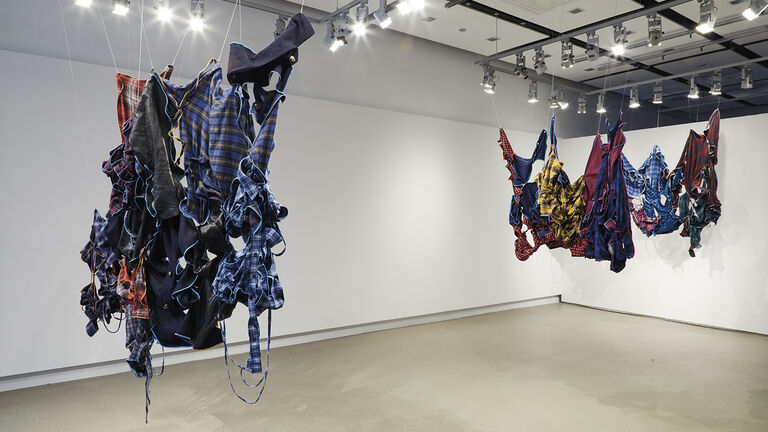
© 2017 School of the Art Institute of Chicago; All Rights Reserved Artwork: Maria Burundarena
Graduate Overview
Fiber & Material Studies Graduate Overview
The Fiber and Material Studies department is research-based, concept-driven, and resolutely engaged with hands-on making. Born from textile traditions, the Fiber and Material Studies department encourages students to think both about and through materials, investigating technique and expanding the use of the medium. Led by an impressive and diverse group of faculty, Fiber and Material Studies is the largest program of its kind. It is the top producer of talent in the field considered in terms of teaching, leadership, tenure and tenure-track positions at almost every other US fiber and textile program. FMS alumni also go on to successful careers as artists, curators, and scholars, and several have founded and/or lead arts organizations, collective studios, and artist residencies.
The department emphasizes technical skills development together with deep engagements with textile processes, materials, techniques, histories, and politics. Graduate students work across a wide range of fiber techniques and materials, and they also work with painting, lens-based media, ceramics, sculpture, new media, drawing, archival research practices, installation, performance, scholarly and creative writing, collaborative projects, and community organizing.
Hands-on making, Research-Based, Concept-Driven
Graduate students in Fiber and Material Studies take studio classes, seminars, and in-depth advising with faculty of their choosing. The FMS curriculum provides students with the foundation to engage with the history of the medium and understand current developments in the field. Graduate Seminars include in depth critiques and discussions of practice, research presentations, lectures, studio visits and discussions with visiting artists and scholars.
Some of the ideas and issues that are evident throughout the department's course offerings include: the politics of craft and hand making; relationships between analog and digital; sustainability; intersectionality; labor; affect, and identity. These themes are investigated from a variety of perspectives, with students drawing from frameworks including textile history, art theory and criticism, intersectional feminism, queer theory, decolonial and critical race studies, material culture studies, transgender studies, textile conservation and textile collections, and archival research.
Graduate students in the Fiber and Material Studies department have significant opportunities for teaching and research assistantships, studio visits with guest artists and curators, and presenting their work through lectures and social media takeovers.
Transdisciplinary Possibilities
In addition to a focus on fiber and textiles, the Fiber and Material Studies department embraces transdisciplinarity and the permeability of boundaries, beginning with the varied expertise of our faculty who work in the discipline and in painting, sculpture, performance, creative writing, and scholarship. Graduate students are encouraged to take courses in other departments to explore and implement the techniques and particular rigors of various disciplines in order to enrich and deepen their practices. Students may work with fiber-based materials while at the same time advising with faculty in departments from across SAIC.
Graduate Studio Projects
A cornerstone of the SAIC graduate studio program is its focus on tutorial-guided studio practice. Each semester, you will select from more than 100 graduate faculty advisors representing myriad disciplines, approaches, and intellectual positions. As the main component of your studies, MFA 6009: Graduate Projects allows you to develop your work with faculty who guide you through an informed dialogue around content, form, theory, and professional practice.
Textile Resource Center
The Textile Resource Center (TRC) is a hands-on teaching/study collection and a curricular resource of over 450 textile objects and more than 2000 books. The TRC supports student learning about global textile histories and contemporary themes. The TRC offers two, year-long graduate research assistantships to FMS graduate students.
Mitchell Lecture Series
The curriculum is augmented with onsite lectures by prominent national and international artists and scholars thanks to The William Bronson and Grayce Slovett Mitchell Lectureship in Fiber and Material Studies. Past lecturers include Angela Hennessy, Hong Hong, Jeffrey Gibson, Dr. Christine Checinska, Namita Gupta Wiggers, T'ai Smith, Tanya Aguiniga, and Diedrick Brackens.
Curriculum & Courses
-
The Master of Fine Arts (MFA) program at SAIC is designed to offer maximum flexibility in addressing your individual needs as a student. Following admission through a department, you will design your two-year plan of study based on optimizing the offerings and opportunities available throughout SAIC. You are encouraged to seek out curricular advising as needed from a variety of available sources including the dean, graduate dean, graduate division chair, department heads, academic advising, the graduate admissions office, and your peers.
Studio—MFA 6009 Graduate Projects, Seminars and/or maximum of 12 credits of 3000-level and above studios 39 Art History 12 - ARTHI 5002 Graduate Survey of Modern and Contemporary Art OR ARTHI 5120 Survey of Modern and Contemporary Architecture and Design(3)
- Art History Courses, 4000-level or above (9)
Electives—any course in any area at 3000 level or above 9 Participation in four graduate critiques Participation in ONE of the following as appropriate to artistic practice:* Graduate Exhibition, AIADO or Fashion Exhibition, Graduate Performance Event, Graduate Screenings Total Credit Hours 60 *Students who wish to use an alternative venue or presentation outside of these options must receive permission from the Dean of Graduate Studies. The AIADO Department encourages students in their MFA design programs to participate in the AIADO and Fashion Graduate Exhibition.
Degree Requirements and Specifications
Completion schedule: You have a maximum of four years to complete your MFA in Studio degree. This includes time off for leaves of absence. Students will have access to studios for four semesters only.
Transfer credits: You must complete a minimum of 45 credit hours in residence at SAIC. You can request up to 15 transfer credits at the time of application for admission, which are subject to approval at that time. No transfer credits are permitted after a student is admitted.
Art History requirement: MFA students are required to take ARTHII 5002 Graduate Survey of Modern and Contemporary Art OR ARTHI 5120 Survey of Modern and Contemporary Architecture and Design. Art History courses must be at the 4000-level and above.
Undergraduate studio courses: Graduate students are permitted no more than one undergraduate studio course (3000-level and above) per semester without permission of the Dean of Graduate Studies. Courses at the 1000 and 2000-level are allowed only with permission.
Full-Time Status Minimum Requirement: 12 credit hours
MFA 6009 Graduate Projects
MFA 6009 Graduate Projects advising, an ongoing individual dialogue with a wide range of full-time and part-time faculty advisors, is at the heart of the MFA program at SAIC, encouraging interdisciplinary study across the curriculum. You are required to register for one MFA 6009 Graduate Projects advisor each semester, and we highly recommend you register for two.In the registration process, you may elect to earn 3 or 6 hours of credit with each advisor. This option is designed to allow for maximum flexibility in designing your program. You can earn as few as 3 and as many as 6 credits with each advisor each semester, thus dedicating a maximum of 12 credit hours to your studio activity. The number of credits you earn has no correlation with the length or frequency of the advising sessions or to faculty assessment of student work.
The remainder of credits required for the full-time 15 credit hour load may include graduate seminars and academic or studio electives. MFA students are urged to take graduate seminars, and an introductory seminar in their department of admission is highly recommended. In addition, the MFA student may choose from all the art history, studio, and academic offerings across the curriculum (including undergraduate offerings above 3000 level) in any given semester to customize their degree experience.
Graduate Critiques
As one of the principle means of assessment each semester, you will be required to participate in Critique Week, a week-long schedule of critiques during which classes are suspended.Fall semester critiques are organized by department with panels representing the discipline. This provides you with an opportunity to understand the department’s expectations, have your work reviewed from a disciplinary point of view, and to reiterate the expectations for graduate study.
Spring semester critiques are interdisciplinary, with panel members and students from across SAIC disciplines. Interdisciplinary critiques allow for a broad range of responses to your work, and are intended to assess the success of your work for a more general, albeit highly informed audience. Critique panels include faculty, visiting artists, and fellow graduate students.
Graduate Exhibition or Equivalent
At the conclusion of your studies, you will present work in the SAIC Graduate Thesis Exhibition, other end-of-year events at SAIC, or the Gene Siskel Film Center—or arrange with the graduate dean or division chair for an alternative thesis of equal professional quality. Each year more than 200 graduate students exhibit work, screen videos and films, and present time-based works, writings, and performance to a collective audience of 30,000 people.Students wishing to install work around prevalent themes, strategies or stylistic affinities can participate in a juried and curated section of the SAIC Graduate Thesis Exhibition. A faculty and staff committee conducts extensive studio visits and as a collaborative project with student participants, organizes and installs the show in designated space at the exhibition.
Undergraduate Courses
MFA students are advised to understand the expectations of their faculty when enrolled in undergraduate studio classes. Although graduate students are an asset to the group dynamic, faculty requirements for graduate students in undergraduate classes are variable. The student is responsible for understanding the faculty member's expectations about completion of assignments, attendance, and any other criteria for earning credit. To assure that graduate students are working at degree level, they are permitted no more than one undergraduate studio course (3000 level and above) per semester without permission of the dean of graduate studies. Courses at the 1000 and 2000 level are allowed only with permission.
Take the Next Step
MFA in Studio Admissions Information
Visit the graduate admissions website or contact the graduate admissions office at 312.629.6100, 800.232.7242 or gradmiss@saic.edu.
